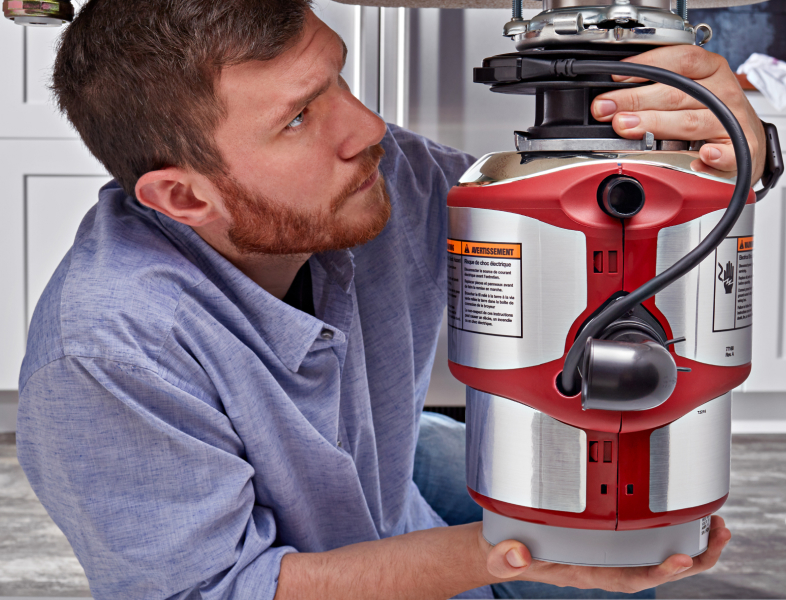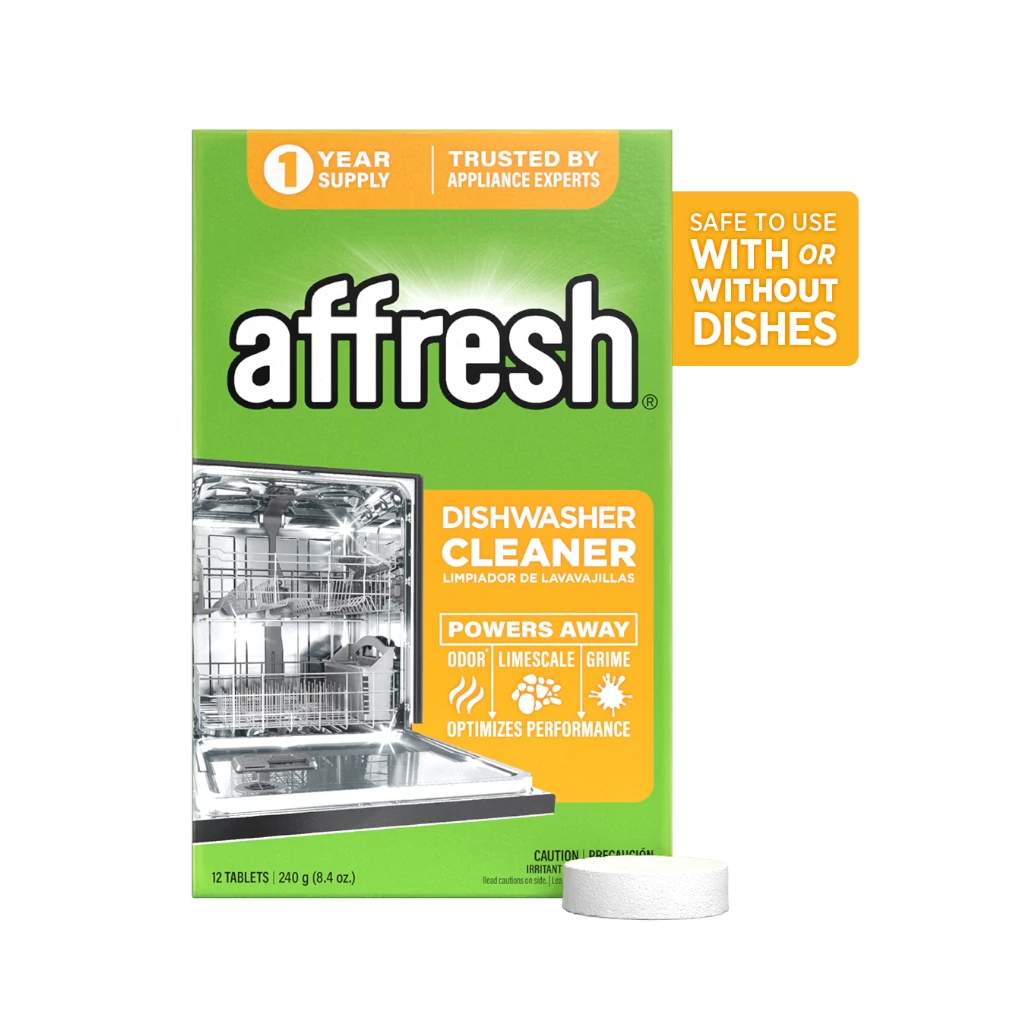
How does a garbage disposal work?
A garbage disposal is an in-sink appliance that helps manage food waste in your kitchen in an efficient and hygienic manner. Garbage disposals, through a grinding process, work with the flow of water from your kitchen faucet to break down food waste into smaller particles that are eventually flushed out into the drain waste line.
Knowing how a garbage disposal works, you can improve the efficiency and longevity of your disposal with proper usage, by avoiding unwanted clogs and jams. Learn more about how a garbage disposal works, the different parts of the appliance and how to use one properly.
- What Are the Parts of a Garbage Disposal?
- How Does a Garbage Disposal Work to Eliminate Food Waste?
- Can You Run a Garbage Disposal Without Water?
- Why Won’t My Garbage Disposal Turn On?
- How Do You Unclog a Garbage Disposal?
What Are the Parts of a Garbage Disposal?
There are six main components of a garbage disposal. These components work together as a holistic system to collect, grind and eliminate food waste. Each component plays a unique role in the grinding process.

- Baffle: This is the circular rubber splash guard that is either placed in the sink flange if the baffle is removable, or located beneath the sink flange if it is non-removable. The purpose of the baffle is to contain splashing water and food waste particles in the disposal while it is running, while simultaneously allowing the user to feed food waste into the disposer.
- Container Body: This is the space located above the shredder plate and below the baffle. The container body is where the grind mechanism is located and where food waste material is introduced to the grinding process after it is fed through the baffle. The grinding process occurs in the upper portion of the grind chamber (located above the shredder plate). The lower portion of the container body is where the ground food waste material and water is flushed out of the disposal and into the waste drain line.
- Motor: The motor is what powers the garbage disposal. When the motor is turned on, it spins a shaft that is attached to the shredder plate. The rotating shredder plate initiates the grinding process.
- Shredder Plate: The shredder plate can be viewed as the “floor” of the disposer. Food waste lands on this shredder plate when it is dropped into the disposer. When the disposer is powered on, the shredder plate will rotate at a high speed. The spinning action of the rotating shredder plate initiates the grinding process by flinging the food waste material into a high velocity vortex that engages with the impellers and grind ring.
- Impellers or Lugs: Attached to the shredder plate via rivets, the impellers resemble small paddles. As the shredder plate spins, the impellers impact the large food waste particles, breaking them into smaller pieces.
- Grind or Shredder Ring: This is a stationary ring that is embedded in the wall of the container body and is responsible for the grinding process. It resembles a circular cheese grater. As the disposer runs, the centrifugal action of the rotating shredder plate slings the food waste along the surface of the grind ring, pulverizing it into smaller particles that are then flushed out of the disposer with the running water.
How Does a Garbage Disposal Work to Eliminate Food Waste?
A garbage disposal uses all its main components to efficiently and hygienically break down food waste. When turned on, the disposal will push food waste through each of its parts to properly reduce the size of food particles before eliminating the waste altogether.
Here’s a breakdown on how the disposal works to grind and flush out food waste material:

1. Turn on Cold Water
The first step is to turn on a strong flow of cold water. Cold water is recommended as it helps maintain any residual fat particles in food waste to remain in a solid state, which will prevent them from sticking to the walls of the waste drain pipes.

2. Turn on Food Waste Disposal
Once a garbage disposal is turned on, the motor begins to spin the flywheel at a high speed.

3. Slowly Add Food Waste
Slowly feed the food waste through the baffle and into the disposal grind chamber a little at a time until all the food waste is gone. Feeding food slowly into the disposal can help the food waste flow freely through the different parts of the appliance during the grinding process. Adding too much food waste at once can slow the grinding process and sometimes result in a jam.

4. Food Waste Is Grinded Down
After food waste is added, the disposal acts like a circular cheese grater, grinding the food waste particles down into smaller pieces that are then flushed out of through the lower grind chamber and into the waste drain line.

5. Turn off the Garbage Disposal and Flush Out the Waste Line
Listen for the grinding sound to abate, then turn off the disposal. Allow the cold water to continue to flow for an additional 15 seconds to fully flush out the drain waste line.
Can You Run a Garbage Disposal Without Water?
Running a garbage disposal without running water is not recommended. A strong flow of cold water is required for your disposal to operate properly. Cold running water assists with the grinding action and helps the waste material flow efficiently through the disposal and into the drain waste line.
Running your disposal without a strong flow of cold water increases the risk of a clog and could result in unnecessary wear on the grind mechanism. Lack of cold running water while using your disposal could also cause it to overheat and shut itself off.


Why Won’t My Garbage Disposal Turn On?
If your garbage disposal won’t turn on, it could be due to electrical issues, such as the power cord being unplugged or an issue with the power source. A clog, jam or broken motor could also be the reason your disposal is not turning on. To troubleshoot, try resetting your disposal. Before resetting, make sure the disposal is plugged in and free from any blockages.
Electrical issues with the power source, a disposal clog or jam and a broken motor could also cause the appliance to stop working altogether. If you experience any of these issues and are unable to fix the problem yourself, you may need to contact a professional for help repairing your disposal.
Two of the most common occurrences of garbage disposal malfunction are clogs and jams.
How Do You Unclog a Garbage Disposal?
A clog occurs when too much food waste material is attempted to be ground at one time, or when a disposal is run without a proper flow of water. The accumulated food waste materials can collect in the p-trap connected to the disposer and form a blockage, causing the water to back up into the sink.
To unclog a garbage disposal, you should first turn the disposer power off. Then, make sure to remove all visible food waste scraps remaining in the sink and disposal. If needed, you can use tongs to remove stubborn food waste scraps that are stuck in the disposal. Once you’ve cleared the clog, you can then use a plunger to flush through any remaining water in the sink.


How Do You Unjam a Garbage Disposal?
A jam occurs when a hard or dense piece of food waste material becomes lodged between the shredder plate and the grind ring. A jam can cause the garbage disposal to overheat, which in turn will cause the thermal overload switch, located inside the disposal, to shut off.
To unjam a garbage disposal, first ensure the power to the disposal is turned off. Using tongs, remove any visible material from the grind chamber. You can then use the hex wrench, sometimes referred to as a jam wrench, by inserting it into the hole on the bottom of the disposer and turning it in both directions to free the jam.
Once the disposal jam is cleared, check to make sure that the red reset button, located on the bottom of the disposer, is pushed back in. The garbage disposal should be ready to operate after following these steps.
If you’re unable to clear a garbage disposal clog or jam by following these steps, you may be encountering a more complex issue with your disposal and should contact a professional plumber for assistance.
Explore affresh® Garbage Disposal Cleaner
Knowing how a garbage disposal works and becoming familiar with the various parts can help you better understand the appliance and ensure it remains running smoothly. With proper use and regular cleaning, your garbage disposal should be able to run efficiently and help keep unwanted odors out of your kitchen.
To clean the disposal grind chamber and grind mechanism, you can use a garbage disposal cleaner tablet, such as affresh®. If your disposal model includes a removable baffle, it is recommended to periodically remove it and either clean it by hand or run it through your dishwasher.
Affresh® disposal cleaner creates a scrubbing action that helps clean your machine’s chopper, internal cavity and hose. Not to mention it also has a citrus scent to help remove odor-causing residues from your disposal. Use monthly or as needed to keep your appliance working smoothly and odor free.












